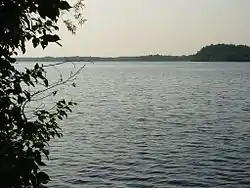Big Sandy Lake
Big Sandy Lake is a lake in Aitkin County, Minnesota, approximately nine miles north of McGregor. The lake is considered fertile walleye ground with several habitat types, including the open main basin, the deep, cold eastern basin, and a shallow, more isolated south basin. Shallow bays containing dense beds of wild rice are found on south, west, and northwest sides of the lake.
| Big Sandy Lake | |
|---|---|
 (June 2006) | |
 Big Sandy Lake  Big Sandy Lake | |
| Location | Aitkin County, Minnesota, U.S. |
| Coordinates | 46.768°N 93.274°W |
| Primary inflows | Sandy River, Prairie River, Aitkin Lake Creek |
| Primary outflows | Sandy River |
| Basin countries | United States |
| Surface area | 6,526 acres (2,641 ha) |
| Max. depth | 84 ft (26 m) |
| Water volume | 134,018 acre⋅ft (0.165309 km3) |
| Shore length1 | 46.6 mi (75 km) |
| Surface elevation | 1,216 ft (371 m) |
| Islands | 25 [1] |
| References | [1] |
| 1 Shore length is not a well-defined measure. | |
Public access is provided by the Minnesota Department of Natural Resources at two locations, the first on the Sandy River north of the "Pier 65" bridge, and the second on the northeast side of the lake. Additional points of access are maintained by the Corps of Engineers and Shamrock Township.
Features
Big Sandy Lake became a reservoir in 1895 when the United States Army Corps of Engineers built a dam on the Sandy River. When the dam was built it included a lock to allow boats to travel out to the Mississippi River. The lock has since been shut down and the lock house has been turned into a small museum containing local artifacts. Big Sandy Lake has three major tributaries; Sandy River, Prairie River, and Aitkin Lake Creek. Sandy River enters the lake from the south and empties back into itself after the Big Sandy Dam, on the northwest corner. Priaire River enters the lake from the east into Bill Horn Bay. Aitkin Creek enters the lake from the northwest, near the Big Sandy dam.
Culture
Big Sandy Lake was inhabited by the Dakota Sioux until they were forcibly removed by the Ojibwa. In the Ojibwa language, the lake is known as Mitaawangaagamaa, meaning "Lake with flat, sandy beaches." The lake is home to the Sandy Lake Band of Mississippi Chippewa who are now part of the Mille Lacs Band of Ojibwe, but have been working on regaining their independent recognition by the Bureau of Indian Affairs. The Minnesota DNR also owns one island in Bill Horn Bay that they preserve. In the 1800s this was the island where the Sioux women and children hid from the attacking Ojibwa.
In 1798, North West Company maintained a post on the western side of the lake; in 1830, American Fur Company established a post at the confluence of the Sandy River with the Mississippi River, a short distance west of the lake. Originally located on the north shore of Big Sandy Lake, the village of Gaa-mitaawangaagamaag was the western terminus of the Northwest Trail that connected the Mississippi River with the Saint Louis River; Savanna Portage State Park that commemorates this historic trail is located on the northeastern shore.
In 1850, the United States attempted to remove the Ojibwa population out of Michigan and Wisconsin to areas west of the Mississippi River, resulting in the Sandy Lake tragedy. A memorial commemorating the Sandy Lake tragedy was established at the United States Army Corps of Engineers Sandy Lake Dam Campgrounds. Along Minnesota State Highway 65, a rest area with a view of Sandy Lake was established, enhanced with a Historical Marker plaque to commemorate the Sandy Lake tragedy.
| Wikimedia Commons has media related to Big Sandy Lake. |
References
- Lake Information Report. Accessed 1 July 2007.
- https://web.archive.org/web/20070709001405/http://www.bigsandyhillcrestresort.com/big_sandy_lake1.htm
- http://myfishingpals.com/Minnesota-Lake-Maps/bigsandy.pdf
- http://myfishingpals.com/ Big Sandy Fishing Reports
- U.S. Geological Survey Geographic Names Information System: Big Sandy Lake